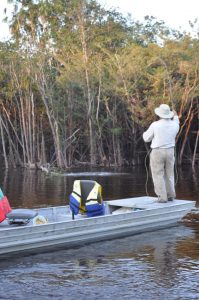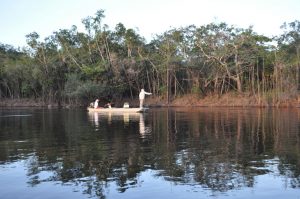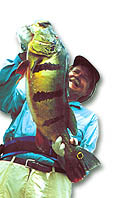Fishing Tactics
 Like largemouth bass, peacocks often prefer “structure” of some sort. Rocks, fallen logs, points and sand bars are hiding places for baitfish, so this is where the peacocks will usually be lurking. Of course, you should always heed the guide’s recommendations on where to cast.
Like largemouth bass, peacocks often prefer “structure” of some sort. Rocks, fallen logs, points and sand bars are hiding places for baitfish, so this is where the peacocks will usually be lurking. Of course, you should always heed the guide’s recommendations on where to cast.
Peacocks usually roam about in small schools searching for baitfish, often bursting into a feeding frenzy. When this situation is encountered, get your fly or lure in front of the feeding fish as soon as possible. The sooner you cast to them after they’ve been spotted, the better your chance of a hookup. Peacocks are greedy and highly competitive schooling fish. Always cast a lure or fly right next to any hooked fish. Another peacock will almost always be close by (attracted by the commotion). If no strikes result, fish the surrounding area thoroughly.
Novice peacock anglers tend to set the hook too fast when fishing top water lures or flies. Often peacocks will just slap at the lure to stunt it and then come back around and firmly grab it on the second pass. It’s hard to remember at first, but don’t set the hook on the strike. If you can’t see the plug or fly after about three seconds, drop your rod tip and set the hook as hard as you can. Big peacocks have very tough skin around their mouths and tend to grip the plug or fly firmly.
 If the fish doesn’t take the lure on the first strike, keep moving it. If you are patient, the fish will usually come up and hit the lure a second or third time. If it loses interest quickly, cast a diving (subsurface) lure or fly. This often elicits another strike.
If the fish doesn’t take the lure on the first strike, keep moving it. If you are patient, the fish will usually come up and hit the lure a second or third time. If it loses interest quickly, cast a diving (subsurface) lure or fly. This often elicits another strike.
Never try and “horse” a big peacock, and don’t underestimate their power. If a big fish is headed for structure, apply side pressure to the rod trying to “steer” the fish in another direction. If you crank your drag down too tight, they’ll almost always snap the line, or pull off. If a fish does make it into cover, don’t give up. Always keep a high rod tip and a loose drag to absorb last minute runs.
Lure or fly color doesn’t seem as important as lure shade. If it is bright, use a light-colored lure/fly. Dark shades are more productive in low light conditions.
Some basic lure guidelines to help you catch more fish
 It is usually best to start with a top-water lure. If the water is off-color or there is a slight chop, a propeller-type top-water lure (like the 6.5″ and 7.5″ RipRoller) will attract the fish’s attention. If the water is completely calm (and/or clear), it may be wise to try a more subtle top-water lure like a 4-1/2″, 3/4 oz. Heddon ‘Zara Spook’.
It is usually best to start with a top-water lure. If the water is off-color or there is a slight chop, a propeller-type top-water lure (like the 6.5″ and 7.5″ RipRoller) will attract the fish’s attention. If the water is completely calm (and/or clear), it may be wise to try a more subtle top-water lure like a 4-1/2″, 3/4 oz. Heddon ‘Zara Spook’.
If the fish refuse to take top-water, switch to a subsurface lure. If the water is clear, lures WITHOUT a sound chamber (i.e. Cotton Cordell’s 7″, 1 oz. ‘Red Fin’) seem to be productive. If the water is off-color, use a lure with a sound chamber (Bill Luis 3/4 oz. ‘Mag-Trap’, or 1-1/2 oz. ‘Super-Trap’)
In hot/bright light conditions a deep diving lure such as a Bill Luis ‘Rattle Trap’ (3/4 oz. ‘Mag-Trap’, or 1-1/2 oz. ‘Super-Trap’) may be your best choice.
A good supply of 1/2 oz. bucktails (tied on saltwater hooks) will elicit strikes from spawning fish which are not in the feeding mode. Try varying the retrieve until you start getting strikes.
Check our tackle recommendations: Peacock Bass Fishing Tackle
